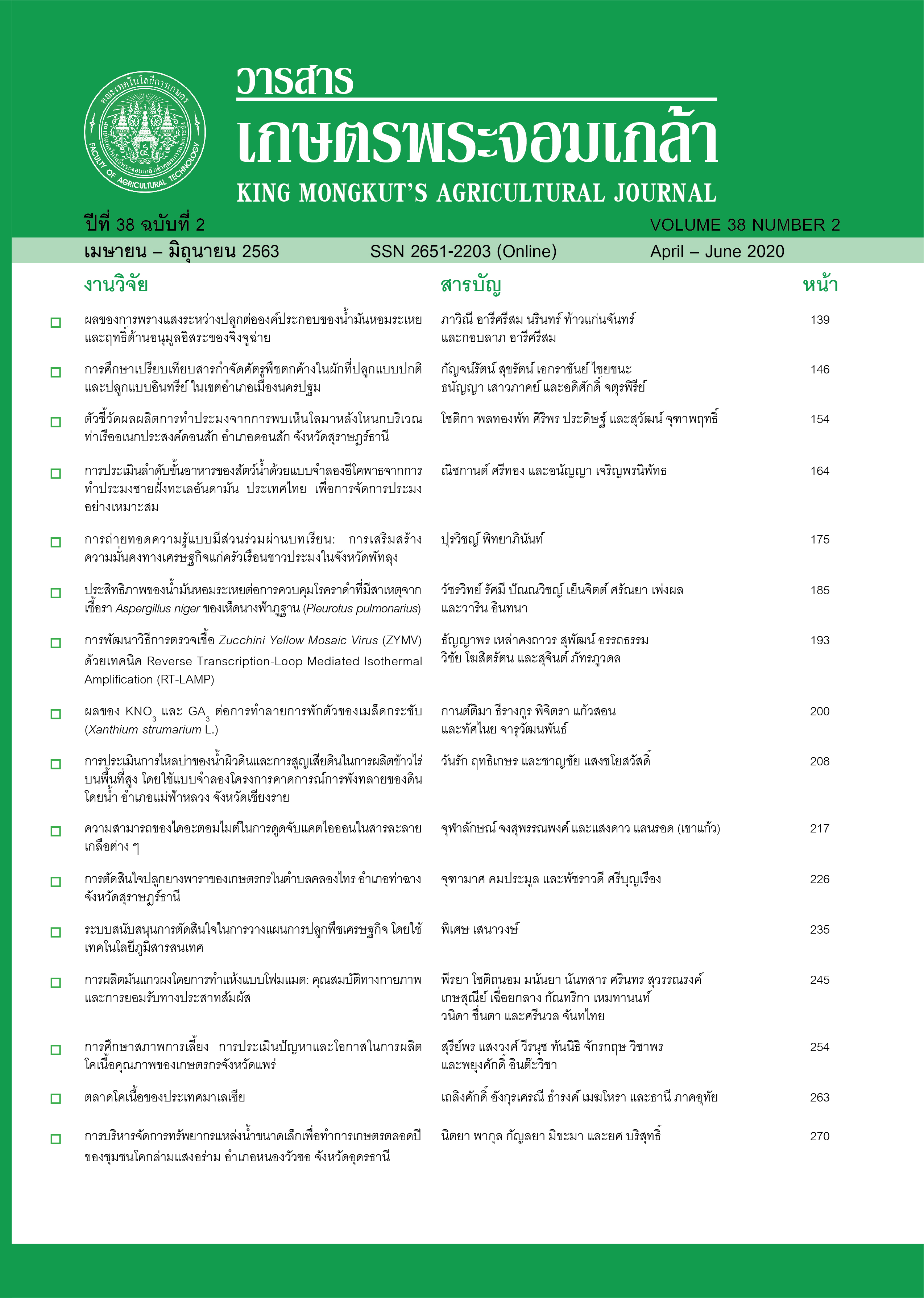ผลของการพรางแสงระหว่างปลูกต่อองค์ประกอบของน้ำมันหอมระเหยและ ฤทธิ์ต้านอนุมูลอิสระของจิงจูฉ่าย
Main Article Content
บทคัดย่อ
งานวิจัยนี้มีวัตถุประสงค์เพื่อทำการศึกษาผลของการพรางแสง (ไม่พรางแสง, 50, 60 และ 70%) ต่อฤทธิ์ต้าน
อนุมูลอิสระและองค์ประกอบทางเคมีในจิงจูฉ่าย โดยวางแผนการทดลองแบบสุ่มสมบูรณ์ (CRD) ประกอบด้วย 3 ซ้ำ
จากผลการทดลองพบว่าการพรางแสงมีผลต่อฤทธิ์ต้านอนุมูลอิสระอย่างมีนัยสำคัญทางสถิติเมื่อทดสอบด้วยวิธี DPPH และ ABTS โดยจิงจูฉ่ายที่ปลูกภายใต้การพรางแสง 60 และ 70% มีฤทธิ์ต้านอนุมูลอิสระ DPPH มากกว่าจิงจูฉ่ายที่ปลูกในสภาพ
ไม่พรางแสง โดยมีค่า IC50 เท่ากับ 39.24±3.32 และ 38.52±0.30 มิลลิกรัม/มิลลิลิตร ตามลำดับ ส่วนจิงจูฉ่ายที่ปลูกในสภาพพรางแสง 70% มีฤทธิ์ต้านอนุมูลอิสระ ABTS มากกว่าจิงจูฉ่ายที่ปลูกในสภาพไม่พรางแสง โดยมีค่า IC50 เท่ากับ 30.07±1.68 มิลลิกรัม/มิลลิลิตร จากการวิเคราะห์องค์ประกอบทางเคมีของน้ำมันหอมระเหยด้วย GC-MS พบว่ามีองค์ประกอบหลัก ได้แก่ a-farnesene, caryophyllene, a-humulene, germacrene D, santolina triene, b-ocimene และ b-sesquiphellandrene โดยการปลูกแบบไม่พรางแสงพบว่ามีสาร caryophyllene และ a-humulene การพรางแสงร้อยละ 50 มีสาร a-farnesene,
b-sesquiphellandrene และ germacrene D และการพรางแสงร้อยละ 60 มีสาร santolina triene และ b-ocimene
เป็นองค์ประกอบหลัก ในขณะที่เมื่อปลูกภายใต้การพรางแสงร้อยละ 70 พบว่ามีองค์ประกอบทางเคมีในน้ำมันหอมระเหยของจิงจูฉ่ายน้อยที่สุด
Article Details
วารสารเกษตรพระจอมเกล้า
เอกสารอ้างอิง
กัญญกาญจน์ พูนศิริ และกัลยา กองเงิน. 2557. อิทธิพลของความเข้มแสงต่อสรีรวิทยาบางประการและการเปลี่ยนแปลงของโปรตีน
ในใบข้าวเหนียวดำ. ใน การประชุมวิชาการเสนอผลงานวิจัยระดับบัณฑิตศึกษา ครั้งที่ 15. น. 882-890.
อาคารวิทยาลัยการปกครองท้องถิ่น มหาวิทยาลัยขอนแก่น, ขอนแก่น.
ทศพล วรรักษ์กุลวงศ์ และสุรวิช วงศ์สวัสดิ์เวช. 2555. ฤทธิ์ต้านการแบ่งตัวของเซลล์และฤทธิ์ต้านอนุมูลอิสระของสารสกัดสมุนไพรจิงจูฉ่าย. โครงการพิเศษปริญญาเภสัชศาสตรบัณฑิต, ภาควิชาเภสัชวินิจฉัย คณะเภสัชศาสตร์ มหาวิทยาลัยมหิดล.
พัชรีวรรณ พุ่มเทศ, ธีรพร กงบังเกิด, กมลวรรณ โรจน์สุนทรกิตติ และนิติพงศ์ จิตรีโภชน์. 2555. ผลของสภาวะการสกัดต่อกิจกรรมการต้าน
อนุมูลอิสระของสมุนไพรไทยบางชนิด. ใน การประชุมวิชาการระดับชาติ วิทยาศาสตร์วิจัย ครั้งที่ 4. น. 52-55. คณะวิทยาศาสตร์ มหาวิทยาลัยนเรศวร, พิษณุโลก.
ภาณุมาศ ฤทธิไชย, เยาวพา จิระเกียรติกุล และรัชชพร เรืองศรี. 2555. ผลของการพรางแสงต่อการเจริญเติบโต การให้ผลผลิต
และสารต้านอนุมูลอิสระของดอกพระจันทร์ (Ipomoea alba L.). วารสารวิทยาศาสตร์และเทคโนโลยี 20(4): 339-347.
ภาวิณี อารีศรีสม, นรินทร์ ท้าวแก่นจันทร์, วาริน สุทนต์, เทิดศักดิ์ โทณลักษณ์ และกอบลาภ อารีศรีสม. 2560. ผลของระยะเวลาเก็บเกี่ยว
ต่อการเจริญเติบโตและปริมาณสารประกอบฟีนอลิกรวมของจิงจูฉ่าย. ใน รายงานการประชุมวิชาการประจำปี 2560.
น. 221-228. อาคารเฉลิมพระเกียรติสมเด็จพระเทพรัตนราชสุดา มหาวิทยาลัยแม่โจ้, เชียงใหม่.
สมบุญ เตชะภิญญาวัฒน์. 2548. สรีรวิทยาของพืช. กรุงเทพฯ: ภาควิชาพฤกษศาสตร์ คณะวิทยาศาสตร์ มหาวิทยาลัยเกษตรศาสตร์.
Ali, M. B. 2014. Secondary metabolites and environmental stress in plants: biosynthesis, regulation, and function.
In Physiological Mechanisms and Adaptation Strategies in Plants under Changing Environment, P. Ahmad and
R. M. Wani, eds. pp. 55-85. New York: Springer.
Chang, X., Alderson, P. G., and Wright, C. J. 2008. Solar irradiance level alters the growth of basil (Ocimum basilicum L.)
and its content of volatile oils. Environmental and Experimental Botany 63(1-3): 216-223.
Chao, P. Y., Lin, S. Y., Lin, K. H., Liu, Y. F., Hsu, J. I., Yang, C. M., and Lai, J. Y. 2014. Antioxidant activity in extracts of 27 indigenous Taiwanese vegetables. Nutrients 6(5): 2115-2130.
Chew, Y. L., Lim, Y. Y., Omar, M., and Khoo, K. S. 2008. Antioxidant activity of three edible seaweeds from two areas in
South East Asia. LWT - Food Science and Technology 41(6): 1067-1072.
Faiola, C. L., Buchholz, A., Kari, E., Yli-Pirilä, P., Holopainen, J. K., Kivimäenpää, M., Miettinen, P. et al. 2018.
Terpene composition complexity controls secondary organic aerosol yields from scots pine volatile emissions.
Scientific Reports 8(3053): 1-13.
Gleizes, M., Pauly, G., Bernard-Dagan, C., and Jacques, R. 2006. Effects of light on terpene hydrocarbon synthesis in
Pinus pinaster. Physiologia Plantarum 50(1): 16-20.
Huner, N. P. A., Oquist, G., and Sarhan, F. 1998. Energy balance and acclimation to light and cold. Trends in Plant Science 3:
-230.
Jing, Z. W., Su-ying, Z., and Yuan-yi, Y. 2011. Analysis of chemical components of volatile oil from Artemisia Lactiflora
Wall in north Guizhou province of China. Medicinal Plant 2(6): 59-61.
Li, Y., Craker, L. E., and Potter, T. 1996. Effect of light level on essential oil production of sage (Salvia officinalis) and thyme
(Thymus vulgaris). Acta Horticulturae 426: 419-426.
Lin, F. D., Luo, D. W., Ye, J., and Xiao, M. T. 2014. Chemical constituents of Artemisia lactiflora (II). Zhongguo Zhong Yao Za Zhi. 39(13): 2531-2535.
Lin, L. J., Hsiao, Y. Y., and Kuo, C. G. 2009. Discovering indigenous treasures: promising indigenous vegetables
from around the world. Taiwan: The World Vegetable Center.
National Institute of Standards and Technology Standard Reference Data Program, Gaithersburg, MD 20899.
NIST 08 MS Library and MS Search Program Version 2.0f.
Paez, A., Gebre, G. M., Gonzalez, M. E., and Tschaplinski, T. J. 2000. Growth, soluble carbohydrates and aloin concentration of
Aloe vera plants exposed to three irradiance levels. Environmental and Experimental Botany 44: 133-139.
Singh, R. P., Chidambara, K. N., and Jayaprakasha, G. K. 2002. Studies on the activity of pomegranate (Punica granatum)
peel and seed extracts using in vitro models. Journal of Agriculture and Food Chemistry 50(1): 81-86.
Somporn, C., Kamtuo, A., Theerakulpisut, P., and Siriamornpun, S. 2012. Effect of shading on yield, sugar content, phenolic acids, and antioxidant property of coffee beans (Coffea Arabica L. cv. Catimor) harvested from north-eastern Thailand.
Journal of the Science of Food and Agriculture 92(9): 1956-1963.
Souza, M. A. A., Santos, L. A., Brito, D. M. C., Rocha, J. F., Castro, R. N., Fernandes, M. S., and Souza, S. R. 2016.
Influence of light intensity on glandular trichome density, gene expression and essential oil of menthol mint
(Mentha arvensis L.). Journal of Essential Oil Research 28(2): 138-145.
Thaipong, K., Boonprakob, U., Crosby, K., Cisneros-Zevallos, L., and Byrne, D. H. 2006. Comparison of ABTA, DPPH, FRAP, and ORAC assays for estimating antioxidant activity from guava fruit extracts. Journal of Food Composition and Analysis 19: 669-675.


